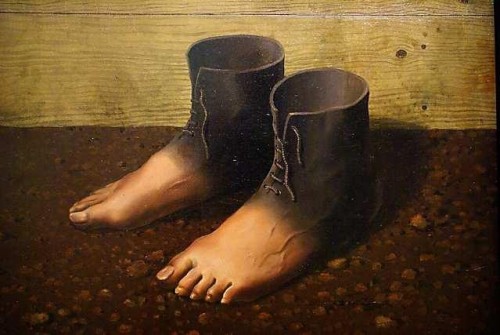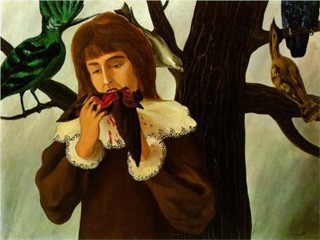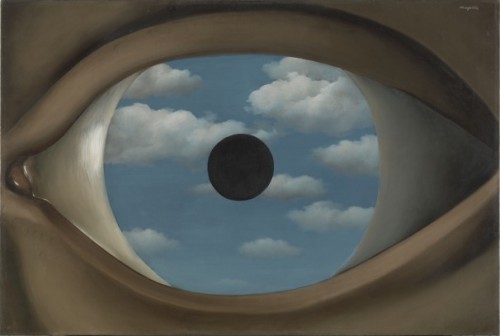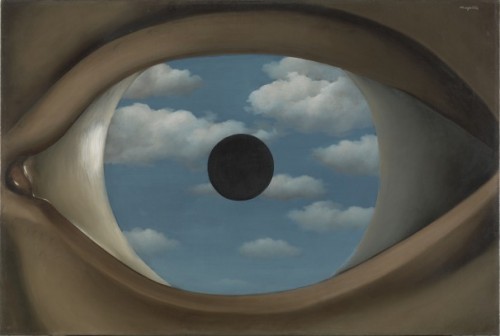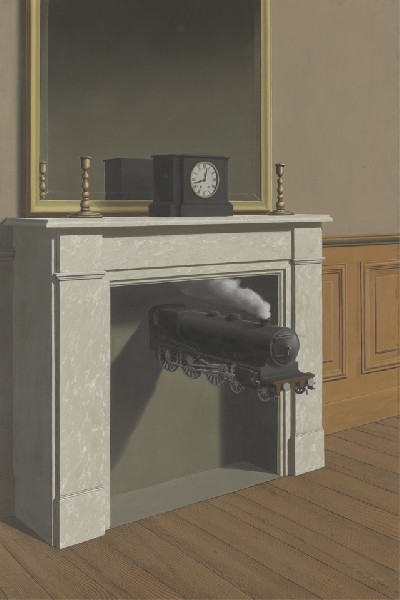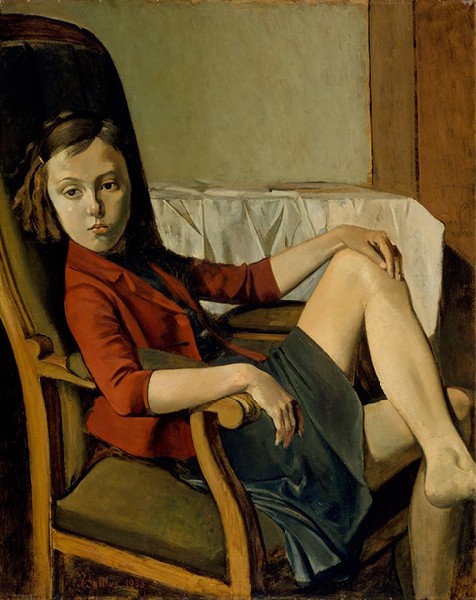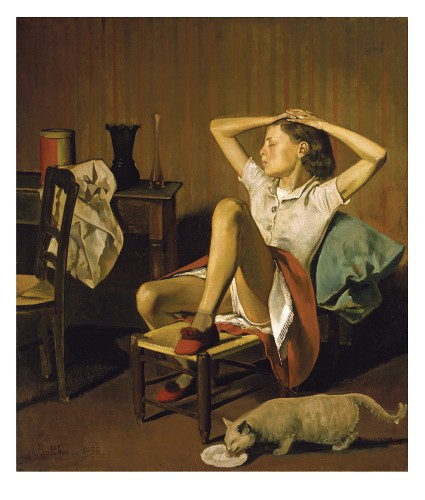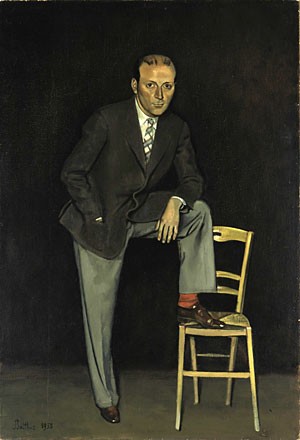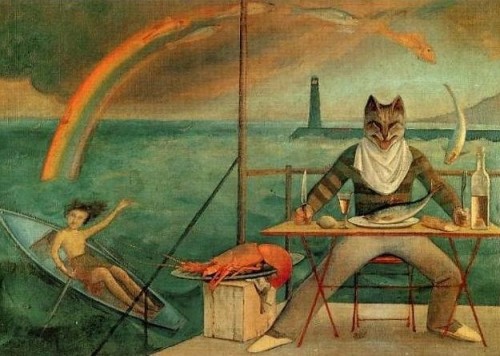Balthus at the Met and Magritte at MoMA
Surrealist Holiday in New York
By: Charles Giuliano - Dec 19, 2013
Balthus: Cats and Girls — Paintings and Provocations
Metropolitan Museum of Art
Through January 12
Magritte: The Mystery of the Ordinary, 1926-1938
Museum of Modern Art
Through Jan. 12.
Menil Collection, Houston, Feb. 14-June 1, and the Art Institute of Chicago, June 22-Oct. 12.
Through January 12 there is a surrealist celebration on view in New York. The Metropolitan Museum of Art has a small and concise exhibition Balthus: Cats and Girls — Paintings and Provocations. While MoMA is presenting a larger retrospective Magritte: The Mystery of the Ordinary, 1926-1938.
Both artists were leading exponents of Dream Surrealism. Another category is Automatic Surrealism. In general surrealist artists pursued one or the other approaches. Notably, Max Ernst explored both sides of the equation.
As Dream implies the work of Magritte and Balthus is literal, representational and evokes images gleaned from the subconscious as pioneered in the psychoanalytic techniques of Sigmund Freud.
That notion is now so fixed in our cultural vocabulary that it is common to describe unusual and evocative experiences as somewhat surreal.
Compared to the formal explorations of modernism, such as cubism, the technique of dream surrealism is retro and conservative.
Take away the symbolism and visual puns of Magritte, or the fantasy eroticism of Baulthus, and overall their work is mundane. Neither artist was particularly adept as a painter or innovator. They may be evaluated as illustrators with a twist.
A tour of a Magritte exhibition, however, brings a smile to our face. The wit and cleverness is undeniable. But once you connect with the joke or visual pun that’s about it. Prolonged contemplation and visual analysis do not reveal other, deeper levels of meaning.
As Yogi Berra might note, walking through the Magritte exhibition of which there have been others that preceded it, is like déjà vu all over again.
If you are uninitiated to the work of Magritte then lucky you. There is nothing like that hilarious first encounter. In my case, alas, that was decades ago.
During a recent romp through the MoMA exhibition it was great fun to revisit old friends. How droll of the artist painting his own woman in the tradition of Pygmalion. What a hoot to encounter depictions of shoes in the form of feet. Ages ago we unraveled the pun of “Ceci n'est pas une pipe” No it is not a pipe. It’s a painting of a pipe. Or the enclosed framed area of a painting with the word “Ciel” which signifies but does not render the sky.
While Magritte is not in the top tier of the most challenging among the modernists he remains on the short list of most popular. Hence, this exhibition is perfect for the large crowds of the New York Holiday season.
I always enjoyed Magritte finding him droll and benign.
Coming out of a major Magritte retrospective at the Met some years ago I was disabused of that notion. It was Sunday afternoon at closing time. Passing me on the steps a young man was livid and lashing into his date. He fumed that she had taken him to see “stupid pictures like a locomotive steaming out of a fireplace.” The wit escaped him. She assured him that next time they would attend a hockey game.
Similarly, I had a rough encounter with a student during a tour of a Balthus retrospective some years ago at The Museo Nacional Centro de Arte Reina Sofía in Madrid. It was during a Spring break visit to Spain and I volunteered to take students of see “Guernica” and other treasures.
The female student, a psychology major, was shocked and offended by what she interpreted as smarmy, prurient and arguably pedophiliac imagery.
The current exhibition focuses on that provocative aspect of his work.
Rather than a full retrospective the Met’s Balthus show is small and concise. There are 34 paintings of mostly adolescent girls nine of which include cats. They were painted between 1935 and 1959.
Balthus was born Balthasar Klossowski (1908-2001). During his early career the artist struggled until he found the support of the art dealer Pierre Matisse. Not in this exhibition but elsewhere in the museum we encountered a superb portrait of the gallerist with his leg pulled up and supported by a chair. The exhibition include a self portrait with a cat.
At some point Bathus managed to purchase a dilapidated French chateau and affected an aristocratic demeanor. It was an aspect of his ego and marketing acumen. Eventually, I read a magazine article asking whether he was the world’s greatest living artist. It was begged by the fact that the artist was then elderly and had outlived more worthy and notable peers.
On many levels Balthus was a pretentious phony but minor when compared to his more outrageous comrade the surrealist Salvador Dali.
Another affectionate word for cat is the double entendre pussy.
One particular painting which hits you between the eyes combines girl and cat/ pussy.
In general the artist had a fixation for looking up the splayed legs of adolescent girls with a glimpse of their panties. It is quite common for prepubescent girls to be oblivious about providing views of their knickers. Polite adults instinctively avert their gaze.
For this painting the artist combined the splayed view of undies and on the floor below an image of a cat licking a saucer of milk. It’s a no brainer to connect the dots. It was disarming to note visitors gliding by the provocative painting with no visible reaction.
His provocative male gaze began when the artist was struggling in his twenties. There is a gallery given over to multiple images of Thérèse Blanchard. Most are intriguing, psychologically penetrating portrait studies. There were other girls later on but never again with such penetrating scrutiny. By then, perhaps, his interest had lapsed from fascination to fetish.
The paintings of Balthus visually violate those innocent girls who sat for them. One wonders why he was not confronted by their parents or even by his wife and family.
As an artist Balthus might be thought of in comparison to Charles Lutwidge Dodgson, (Lewis Carroll) who took nude photos of his muse Alice. One thinks of Lolita by Nabakov or the outsider fantasies of the artist Henry Darger.
There is more to Balthus than little girls and pussies. But this exhibition cuts to the chase.
One of the most interesting works “The Victim” reveals what might have been. Rather like a nude by Modigliani we encounter a prepubescent girl occupying the large horizontal canvas somewhat akimbo. Focusing on her face it is unclear if she is dead or alive. Just what has she been the victim of as the title states? There is ambivalence that some interpret as the artist’s response to the war when the painting was created.
It is the element of doubt in ‘The Victim” that makes it more profound than the sexual fantasies of crotch shot paintings.
Balthus is an odd choice for a Holiday show. It’s not exactly family entertainment.

